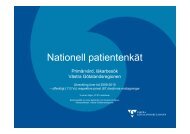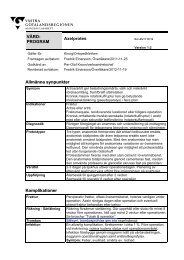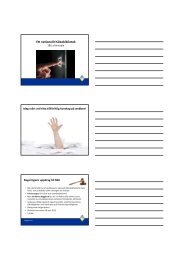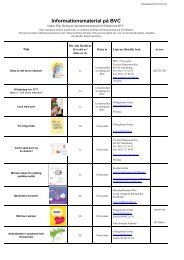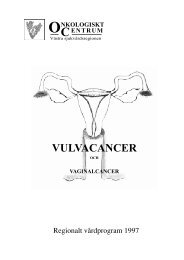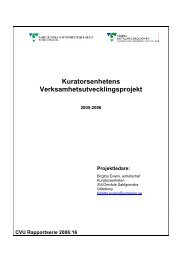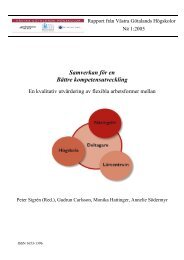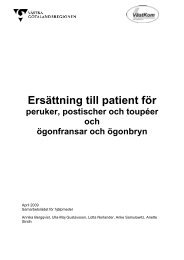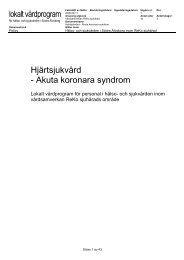AWARENESS AND STIGMA RELATED TO HIV AMONG SEX ...
AWARENESS AND STIGMA RELATED TO HIV AMONG SEX ...
AWARENESS AND STIGMA RELATED TO HIV AMONG SEX ...
You also want an ePaper? Increase the reach of your titles
YUMPU automatically turns print PDFs into web optimized ePapers that Google loves.
<strong>AWARENESS</strong> <strong>AND</strong> <strong>STIGMA</strong> <strong>RELATED</strong> <strong>TO</strong> <strong>HIV</strong> <strong>AMONG</strong><br />
<strong>SEX</strong> WORKERS IN PUNE, INDIA<br />
Sofia Myhrman and Ingrid Gerdin<br />
Correspondence: Ingrid Gerdin, gusgeing@student.gu.se<br />
Sofia Myhrman, gusmyrso@student.gu.se<br />
Supervisors: Rune Andersson, Professor MD, Research and development<br />
centre, Skaraborg hospital, Skövde, Sweden<br />
Lalita Edwards, MD, Pune, India<br />
1
TABLE OF CONTENTS<br />
ABSTRACT _______________________________________________________________ 3<br />
ABBREVIATIONS__________________________________________________________ 4<br />
INTRODUCTION __________________________________________________________ 5<br />
INDIA ________________________________________________________________________ 5<br />
<strong>HIV</strong>/AIDS _____________________________________________________________________ 5<br />
Women living with <strong>HIV</strong>/AIDS (WLHA) in India _____________________________________ 6<br />
Stigma and discrimination _______________________________________________________ 7<br />
Prevention_____________________________________________________________________ 7<br />
ART__________________________________________________________________________ 7<br />
Pune - Budhwar Peth and Hindustani Covenant Church ______________________________ 8<br />
Saheli karyakarta Sangh (SHAKS) ________________________________________________ 8<br />
National AIDS Research Institute (NARI) __________________________________________ 8<br />
METHODS ________________________________________________________________ 9<br />
RESULTS _________________________________________________________________ 9<br />
Age, socio-economic status and level of education among sex workers in Pune ___________ 10<br />
General health ________________________________________________________________ 11<br />
Information about <strong>HIV</strong>/AIDS____________________________________________________ 12<br />
Condom use __________________________________________________________________ 13<br />
Knowledge about <strong>HIV</strong>/AIDS ____________________________________________________ 13<br />
Reasons for <strong>HIV</strong>-testing ________________________________________________________ 14<br />
Living with <strong>HIV</strong> and experiences of stigma and discrimination ________________________ 15<br />
DISCUSSION_____________________________________________________________ 15<br />
Age, socio-economic status, level of education ______________________________________ 15<br />
General health ________________________________________________________________ 16<br />
Condom use __________________________________________________________________ 16<br />
Information and knowledge about <strong>HIV</strong>/AIDS ______________________________________ 16<br />
Reasons for <strong>HIV</strong>-testing ________________________________________________________ 17<br />
Living with <strong>HIV</strong> and experiences of stigma and discrimination ________________________ 17<br />
Limitations ___________________________________________________________________ 18<br />
Acknowledgements:____________________________________________________________ 19<br />
REFERENCES ___________________________________________________________ 20<br />
APPENDIX 1 _____________________________________________________________ 22<br />
Questionnaire _________________________________________________________________ 22<br />
APPENDIX 2 _____________________________________________________________ 27<br />
Questions during the interview___________________________________________________ 27<br />
2
ABSTRACT<br />
<strong>HIV</strong> is widespread among sex workers in Pune, Maharashtra, India (1). Our aim with this<br />
study is to investigate stigma and discrimination from society against the female and<br />
transgender sex workers living Budhwar Peth, known as the red light district area of Pune.<br />
Questions concerning general knowledge about <strong>HIV</strong> and use of condoms were also included<br />
in the study.<br />
The sex workers belong to a low socio-economic group and generally have a low level of<br />
education. Transgenders tend to have attended more years in school, and also reports having<br />
an excellent health to a higher degree than the women. A high number among the sex workers<br />
had been tested for <strong>HIV</strong>, mostly due to illness or for getting “general information”, and many<br />
of the respondents knew an <strong>HIV</strong>-positive person. They were well informed about <strong>HIV</strong>, routes<br />
of transmission and importance of condom use. Female sex workers participating in open<br />
interviews had however several misconceptions. Many of the <strong>HIV</strong>-positive female and<br />
transgender sex workers in the area reported experiences of discrimination and showed<br />
various signs of depression.<br />
Better understanding of the total life situation of people living with <strong>HIV</strong>/AIDS will give<br />
information about where resources are most needed to improve their quality of life. This is<br />
crucial, not only by humanitarian reasons, but also one step in the fight against the spread of<br />
<strong>HIV</strong>.<br />
3
ABBREVIATIONS<br />
FSW - female sex worker<br />
TG - transgender<br />
TGSW - transgender sex worker<br />
MSM - men who have sex with men<br />
IDU - intravenous drug user<br />
STD - sexually transmitted disease<br />
PLHA - people living with <strong>HIV</strong>/AIDS<br />
WLHA - women living with <strong>HIV</strong>/AIDS<br />
SW - sex worker<br />
NSW - non sex worker<br />
NSWTG - non sex working transgender<br />
ART - antiretroviral treatment<br />
GUD - genital ulcer disease<br />
HSV - herpes simplex virus<br />
4
INTRODUCTION<br />
INDIA<br />
With an estimated population of 1.13 billion people, India is the second most populous<br />
country, and the largest democracy in the world. Approximately 40 % of the population speak<br />
Hindi, which is the major language and 80 % are Hindus (2,3). Almost 70 % of Indians live in<br />
rural areas, but migration to larger cities increases. The people living in urban areas contribute<br />
to more than 50 percent of the country’s Gross Domestic Product (GDP) and to 90 percent of<br />
income from taxes (4). After the independence from Great Britain in 1947 India has made<br />
great progress and is today one of the fastest growing economies in the world (3) and a leader<br />
in such fields as information technology, pharmaceuticals and telecommunication. The<br />
incidence of poverty has declined by about 10 percentage the last ten years, although it is still<br />
high with around 30 % of India‘s population living on less than 1US $/day (World<br />
Development Indicators, 2005) (3,5). Educational programs during the last two decades have<br />
led to increased literacy rates with recent data of 73 % among males and 48 % among women<br />
(3). Some of the main issues of the educational system are high dropout rates, social gap, low<br />
participation of girls and low levels of learning achievements. For example, one World Bank<br />
survey found that 25 % of government primary school teachers in India were absent from<br />
work during unannounced inspections (6).<br />
<strong>HIV</strong>/AIDS<br />
Today, estimated 33 million people in the world are living with <strong>HIV</strong>, 93% are over 15 years<br />
of age (7). The first case of <strong>HIV</strong> in India was reported in 1986 among sex-workers in Chennai,<br />
which led to the constitution of The National AIDS Committee by the Indian government (8).<br />
In 1992, India formed their first national AIDS control programme with the National AIDS<br />
Control Organisation (NACO) to carry it through (8). The 2006 AIDS epidemic update by<br />
UNAIDS, estimated that nearly 5.7 million people in India were infected with <strong>HIV</strong> by the end<br />
of 2005. These numbers, compared with 5.5 million in South Africa, captured wide attention<br />
as India now had the highest burden of <strong>HIV</strong> infected people in the world (9). At the end of<br />
2006, new estimates released by NACO, supported by UNAIDS and WHO, indicated that<br />
national adult <strong>HIV</strong> prevalence in India is approximately 0.36 %, which corresponds to an<br />
estimated 2 - 3.1 million people living with <strong>HIV</strong> in the country (7). These estimates were<br />
based on an expanded surveillance system and a revised and enhanced methodology, and<br />
more accurate than the previous ones. For example the number of surveillance sites increased<br />
and now covered all districts in the country. (7,10). Prevalence trend vary among different<br />
states and regions, with the highest rates in Andhra Pradesh, Nagaland and Manipur (over 1.0<br />
%), and Maharasthra, Goa, Karnataka, Mizoram (0.5-1.0 %) (7). Maharashtra comes on<br />
number five, with an estimated prevalence of 0.74 % (10). Although these estimated numbers<br />
are lower than before, <strong>HIV</strong> is still affecting a large number of people. The <strong>HIV</strong> prevalence in<br />
India is the third largest in the world, and remains the largest in Asia (11). Heterosexual sex is<br />
believed to be the most common way of spreading <strong>HIV</strong>. Epidemiological High-risk groups<br />
are; FSW, MSM, IDU and STD clinic attendees (10).<br />
5
Table 1. Estimated prevalence (percent) of PLHA among high-risk groups, India, 2006. (10,1)<br />
FSW MSM IDU STD<br />
India 4.9 6.4 6.9 3.7<br />
Maharast<br />
hra<br />
19.6 15.6 20.4 10.0<br />
Pune 50.0 23.6 N/A N/A<br />
Trends among FSW in the south of India have shown a slight decline, reflecting the impact of<br />
interventions. For MSM there is no change and for IDU the numbers are increasing.<br />
In Pune the prevalence for MSM and FSW has increased between 2004 and 2006 (1).<br />
Percent<br />
Estimated <strong>HIV</strong>-prevalence among<br />
MSM and FSW, Pune<br />
60,0%<br />
50,0%<br />
40,0%<br />
30,0%<br />
20,0%<br />
10,0%<br />
0,0%<br />
2004 2005<br />
Year<br />
2006<br />
MSM FSW<br />
Women living with <strong>HIV</strong>/AIDS (WLHA) in India<br />
Although the overall <strong>HIV</strong> prevalence is decreasing, the percentage WLHA continues to be<br />
around 39 % of total PLHA (10). It’s estimated that around 80-90 % of the women got<br />
infected by their husbands (12). One problem is the “truncated epidemics”, when truckers and<br />
migrants get infected while away from home, and in turn infect their wives when they come<br />
home. Among antenatal clinic attendees in India, women married to men in the transport<br />
industry had the highest burden of <strong>HIV</strong>/AIDS (1). This makes FSW and their clients an<br />
important target population for <strong>HIV</strong> prevention efforts.<br />
Discrimination against women is obvious already when looking at the sex ratio at birth: 1.12<br />
boys/girls (3) as compared to Sweden 1.06 boys/girls (13).<br />
Earlier reports suggest that condom use is gender linked, and that new ways to avoid social<br />
traps needs to be developed. The social norm for the Indian women is that they are not<br />
“supposed” to be sexually knowledgeable, not able to refuse sex or negotiate condom use,<br />
which leads to little control and power in their sexual relationships, including marriage.<br />
Promoting condom use is seen as promoting promiscuity, and the most common means of<br />
contraception is sterilization of women, typically before they turn 30 years (14).<br />
Since many women do not have an education and get denied from financial independence it is<br />
not possible for them to divorce their husbands. If they leave, the poverty leads them into sex<br />
work and thereby a higher risk behaviour (14). When infected, the woman often gets blamed<br />
for bringing the infection into her family, especially if she got tested before the husband,<br />
commonly during pregnancy. If a man gets infected with <strong>HIV</strong>, his wife should stay with him,<br />
6
look after and take care of him, even if it means she is at a high risk to get infected. Women<br />
suffer as much stigma and discrimination as their husbands, often more (15).<br />
Stigma and discrimination<br />
From a medical perspective, stigma leads to more severely ill <strong>HIV</strong>-positive people. The fear<br />
of stigma dissuades people from getting tested early, which in turn lead to more advanced<br />
stages and risk of infecting others. An <strong>HIV</strong>-infected person might fear accessing health care<br />
and taking medicines because this will identify them as positive.<br />
Many times the treatment centre is a separate <strong>HIV</strong>/AIDS ward, and has open charts marked<br />
with biohazard labels. People often feel that they get judged for the past, and that the medical<br />
staff is afraid of touching them and avoid going near if not necessary. Sometimes after an<br />
<strong>HIV</strong>-positive patient has left the hospital, all the linen he/she has used during their stay are<br />
burned (16). There are also reports of discrimination in forms of testing and disclosure without<br />
the patient´s knowledge or consent. Some doctors choose to tell the relatives about the<br />
patients positive <strong>HIV</strong>-status before telling the patient himself (16). One doctor we met with in<br />
Pune, explained this as a way to avoid suicide. If he were to tell the patient first he/she would<br />
commit suicide. Instead he tells the family when receiving the results and later during a few<br />
meetings, step by step tells the patient about the disease.<br />
<strong>HIV</strong>/AIDS is linked to already stigmatised people, for example MSM, SW and IDU. People<br />
with <strong>HIV</strong> are seen as personally responsible and are affected because of “moral fault”. FSW<br />
are blamed of spreading <strong>HIV</strong> to men because only their existence is the cause of spreading<br />
<strong>HIV</strong>, not the men going to them (17). Prostitution, homosexuality and drug use are all illegal<br />
(14). The laws contribute to stigma, harassment and discrimination, creating a sense of “us and<br />
them“.<br />
The stigma leads to loss of job, isolation, physical violence and negative reactions from<br />
partners when negotiating use of condom (18).<br />
Prevention<br />
Rising levels of <strong>HIV</strong> among sex workers and their customers can provide early warnings of<br />
increasing probability that the epidemic will expand into the general population. Condom use<br />
and sexual decision are linked to gender and sexual roles. MSM easier control condom use<br />
and are permissible to speak more open about sex (18). Other methods to avoid social traps<br />
like this need to be developed. Studies show an increase in both condom use, as well as<br />
refusal of customers who demand sex without condom, among FSW attending sexually<br />
transmitted disease clinics in Pune, from 0 % to 54 % between 1998 and 2002. Men also<br />
report using condom with FSW in a higher degree than previous years. There has been a<br />
decline in <strong>HIV</strong>-incidence among male patients and FSW patients with STD´s, although this<br />
has not been seen among women with STD’s who are not engaged in sex work (19,20).<br />
ART<br />
In April 2004, the Government of India launched the free antiretroviral treatment program in<br />
the first eight antiretroviral treatment centres, and later 101 public sector health facilities in 28<br />
of the 35 states. In august 2007, a total of 95,948 patients received treatment from NACO<br />
supported centers (21). ART in governmental hospitals is initiated for PLHA with less than<br />
200 CD 4+ white blood cells/mm3, or PLHA who have developed AIDS but has 200 and<br />
more CD 4+ white blood cells/mm3. Special emphasis is given to the treatment of seropositive<br />
women, and infected children with full-blown AIDS (22).<br />
7
As the access of ART increases, so will the prevalence of <strong>HIV</strong>-infected individuals. Therefore<br />
the need for secondary prevention efforts is crucial (18).<br />
Pune - Budhwar Peth and Hindustani Covenant Church<br />
With 5 million inhabitants, Pune is the second largest city in Maharashtra. It is famous for its<br />
universities but also less flattering for being one of the most polluted cities in India, because<br />
of its many industries and heavy transports.<br />
A lot of people constantly move into the city, mainly to find work. Many of them end up as<br />
sex workers in Red light district. About 6000-8000 people are living here and out of them it is<br />
estimated that around 4000 are sex workers (SW), mostly women, but also transgenders and<br />
men.<br />
Saheli karyakarta Sangh (SHAKS)<br />
Since 1991, the NGO, Peoples Health Organisation has been working with and for the FSW in<br />
Pune. In 1998, the FSW in the area established the first, and up to today, only cooperative<br />
organization for female sex workers in Pune, SHAKS. The vision is ‘empowerment of the<br />
women in sex work through collectivization’. The more forward individuals were encouraged<br />
to become peer educators and spokes persons. Today there are about 500-1000 registered<br />
members at SHAKS. The organization has its office in an apartment located in the heart of<br />
Budhwar Peth, and is funded by the Maharashtra State AIDS Control Society and individual<br />
donations. Among many services, SHAKS has a drop in centre during daytime with the<br />
possibility to get counselling, legal help from voluntary law students in Pune or just a pause<br />
from the busy street. Here is also a community kitchen where women can buy cheap,<br />
nutritious food or if they don‘t have any money, get it for free. During the night, the centre is<br />
closed hence the space is shared with some of the children of the FSW, who live there on a<br />
regular basis. Today there are 24 children living in the apartment, but sadly due to the lack of<br />
space, many more are denied day and night lodging.<br />
A young woman can earn her living on sex work but when she gets older she will not have<br />
enough clients. Because of this, Saheli started sexworkers cooperative bank to get the women<br />
to save money. Everyday they go out in the area and collect money directly from the women<br />
to put into their savings account. Fourteen peer educators inform the women in Budhwar Peth<br />
and nearby areas about general health, condoms, <strong>HIV</strong> and legal rights.<br />
Social worker and counsellor Sarika R Patil, has been working at SHAKS for about a year and<br />
believes that one of the main strenghts of the organization is the trust between the women.<br />
They take care of each other, and help with escort to the governmental hospitals when<br />
someone gets ill. The most common diseases seen in the area are <strong>HIV</strong>-related. PLHA get<br />
thrown out of the brothels, and are discriminated also by the other sex workers. At SHAKS<br />
they have approximately 100 registered <strong>HIV</strong> positive women. In the future there is a need for<br />
more persons who are competent to educate the women, and for better facilities. They would<br />
also like to start a restaurant (23).<br />
National AIDS Research Institute (NARI)<br />
NARI, which was established in 1992 to meet the growing demands of <strong>HIV</strong>-epidemic, leads<br />
different awareness programs and are using <strong>HIV</strong>-positive speakers. The research fields are<br />
medical, social and behavioural. The head office is in America and the organization is funded<br />
from an American company at Atlanta CDC. There is also a main office in Delhi. NARI<br />
works in several Indian states like Maharashtra, Tamil Nadu, Andhra Pradesh and Rajastan.<br />
NARI efforts free treatment, nutrition and clothes for people who are ill (24).<br />
8
METHODS<br />
The project was conducted in Budhwar Peth, Pune. One part of it was handing out<br />
questionnaires with a total of 46 questions (see Appendix 1), about general health, knowledge<br />
about <strong>HIV</strong> and contraceptives. The material is presented in tables and diagrams, constructed<br />
in Microsoft word and excel. For statistical comparisons we calculated proportions with 95 %<br />
confidence intervals. All forms were destroyed after sampling and processing of data.<br />
The second part of the project was open interviews containing 14 questions (see Appendix 2)<br />
with <strong>HIV</strong>-positive female and transgender sex workers living in the area. Ten interviews with<br />
FSW in the ages 26 to 45 years old were conducted at SHAKS. Two of the interviews with<br />
TGSW, were held in one of the brothels, and two were performed at the HCC field office in<br />
Budhwar Peth. The youngest respondent was around 20 years old (correct age was not noted<br />
in this case) and the oldest 40.<br />
The individuals were asked for their approval of participating in the study before meeting<br />
with us, and were informed that their answers would be used in an anonymous way. We had<br />
access to the same female interpretator during all of the interviews, and it was conducted in<br />
Maharahti or Hindi.<br />
Both the form and the oral questions for the interview were translated into Hindi from<br />
English, since Hindi is the language most people know in the district. This was done to reduce<br />
bias from interpretation directly during the conversations, or if the interpretator would be a<br />
different person from one occasion to another.<br />
RESULTS<br />
It was hard to find people in the area willing to participate in the study. The main issues were<br />
the lack of trust regarding the confidentiality and the fear of getting exposed to others as being<br />
<strong>HIV</strong>-positive. There were also demands of getting paid to fill in the forms. After about four<br />
weeks with little success we were asked to do a comparative study between sex workers and<br />
non sex-workers living in the area.<br />
Thanks to volunteers from HCC and NARI, who handed out and helped people to fill in our<br />
forms in the area, we finally collected 113 answered questionnaires, out of 71 were answered<br />
by sex workers and 42 by non-sex workers. All participants are living in the area of Budhwar<br />
Peth. Three forms from the non-sex worker group were excluded from the survey, for the<br />
reason that there were too few answers. One from the SW group was excluded, due to not<br />
filling in the question about gender. As a result we finally had 109 forms, out of which 39<br />
were from the NSW group and 70 were from the SW group.<br />
In the NSW group, 2 persons were <strong>HIV</strong> positive and in the SW group, 5 were <strong>HIV</strong> positive.<br />
Eleven of the persons who were not <strong>HIV</strong> positive in the SW group answered the question<br />
“who they would choose to tell about their <strong>HIV</strong>-positive status”, but we assume this was a<br />
misunderstanding of the question. Since few of the respondents were <strong>HIV</strong>-positive we did not<br />
use that part of the questionnaire in the results. Instead we focused on following topics:<br />
socioeconomic status, level of education, general health status, information about <strong>HIV</strong>, use of<br />
condoms, knowledge about <strong>HIV</strong>-transmission, if tested for <strong>HIV</strong> and if they know any <strong>HIV</strong><br />
positive persons. Unfortunately we got only two answers from women in the NSW group<br />
9
compared to 24 women in the SW group. In the NSW group 27 were men compared to two<br />
men among the sex workers. The NSW group can due to this not be used as control group for<br />
the female and male sex workers.<br />
Age, socio-economic status and level of education among sex workers in Pune<br />
Table 2. Age, sex worker group:<br />
Men<br />
n=2<br />
Women<br />
n=24<br />
TG<br />
n=44<br />
Age 25 21-50 19-51<br />
Average age 25 33 29<br />
Median age 25 30 25<br />
We also got answers from 10 not sex working transgenders (NSWTG) within an age span of<br />
20 to 40 years with an average age of 30 years and median age on 34 years.<br />
Table 3. Socio-economic status (percent) among sex workers in Pune<br />
Good Fair Poor<br />
Men n=2 0 50 50<br />
TG n=44 0 43 57<br />
Women n=24 0 50 50<br />
Among the 10 NSWTG:s 80 % regarded their socio-economic status fair and 20 % poor.<br />
There was no significant difference of the proportion being poor between the SWTG, 57%<br />
(95% CI 43-71) and the FSW 50% (95% CI 40-60). None of the respondents defined their<br />
socio-economic status as good.<br />
10
Table 4. Highest level of education (percent) among sex workers in Pune:<br />
Men n=2 TG n=44 Women n=24<br />
Never been to school 50 11 63<br />
Primary school not<br />
finished<br />
0 7 21<br />
Primary school 0 39 8<br />
Secondary school 50 36 8<br />
High secondary school 0 4 0<br />
college 0 3 0<br />
All of the NSWTG:s had finished primary school and 80 % compared to 43 % in the TGSW<br />
group had attended a minimum of secondary school. Any significant difference could not be<br />
calculated due to the low number of participating NSW. Within the SW group it appears as if<br />
the TG:s had received a higher degree of education than the women, with 84 % of the women<br />
never attending school or not finished primary school compared to 18 % of TG:s. Neither this<br />
could be statistically proved due to not enough material.<br />
General health<br />
Table 5. General health status (percent) among sex workers in Pune:<br />
Sex<br />
Very Poor Ok Good Excellent<br />
workers poor<br />
Men n=2 0 50 50 0 0<br />
TG n=43 5 2 7 33 53<br />
Women<br />
n=24<br />
4 0 25 21 50<br />
There was a tendency towards NSWTG:s to have an excellent health status to a larger extent,<br />
80 % compared to 53 % (95%CI 39-68) for TG:s in the SW group. Within the SW group there<br />
is a similar pattern in health status between TG:s and women.<br />
In the NSW group, 2 respondents reported being <strong>HIV</strong>-positive. In the SW group there were 5<br />
persons with known <strong>HIV</strong>. Other reported illnesses among the SW were 3 with diabetes, 1 with<br />
spondylitis and 1 with tuberculosis.<br />
11
Table 6. Signs of depression and anxiety among a total number of 14 interviewed sex workers.<br />
Constant thoughts about death and worries about the future 12<br />
Persistent sad mood<br />
Negative thoughts about life<br />
Physical symptoms such as headaches, joint pain, stomach ache, weakness<br />
Constant tension<br />
Sleeping disorders<br />
Loss of appetite<br />
Loss of interest in talking to other people and irritability<br />
Feelings of become ugly<br />
Signs of fatigue<br />
Among the interviewee, two had an ongoing tuberculosis-infection and one got treatment for<br />
an STD. Nine of the interviewed persons reported earlier health problems, such as<br />
tuberculosis, pneumonia, diarrhoea and malaria. All of the participants except one reported<br />
various signs of depression and anxiety. Most frequent seen answers were ‘thoughts about<br />
death’, ‘worries about the future’ and ‘persistent sad mood’ but they also reported many<br />
physical symptoms, which could be explained by their <strong>HIV</strong>-infection and opportunistic<br />
infections, but might just as well be psycosomatic. For example we met with a woman who<br />
was terrified that she had a nail infection that would “eat up“ her fingers, without any signs<br />
of infection when we inspected her nails. Another woman described her feelings about her<br />
disease as “before the diagnosis she was pretty and now she has become ugly“. Especially<br />
one of the transgender persons gave the impression of being severely depressed. She<br />
answered the questions in a very quiet voice with very few words and showed minimal facial<br />
mimic, was moving very slowly and only if she had to and she did not have any appetite or<br />
desire to socialize. She did not say anything that she was not specifically asked about.<br />
Information about <strong>HIV</strong>/AIDS<br />
Most of the respondents had received information mostly from doctor/health worker, closely<br />
followed by media and friends, in all three categories. All the ten NSWTG:s gave this answer.<br />
9<br />
4<br />
4<br />
3<br />
3<br />
2<br />
2<br />
1<br />
1<br />
12
Condom use<br />
All the NSWTG:s, reported use of condoms every time they had sex. Most of the sexworkers,<br />
96 %, also answered they used condom every time. Only three of them answered<br />
“quite often” and one of these pointed out that it was always used in penetrating sex.<br />
Knowledge about <strong>HIV</strong>/AIDS<br />
Table 7. Believed routes of <strong>HIV</strong>-transmission (percent) among sex workers in Pune.<br />
Shake<br />
hands<br />
Hug<br />
ging<br />
Ki<br />
ss<br />
intercours<br />
e with<br />
condom<br />
Breast<br />
feedin<br />
g<br />
Throug<br />
h blood<br />
During<br />
delivery<br />
Men n=2 0 0 0 0 100 100 100 50<br />
TG n=43 0 0 0 2 86 98 93 69<br />
Women<br />
n=24<br />
Percent<br />
100<br />
50<br />
0<br />
Information about <strong>HIV</strong>/AIDS among<br />
sexworkers in Pune.<br />
Women<br />
n=23<br />
TG n=41 Men n=2<br />
Parent<br />
Teacher<br />
Friend<br />
doctor/health worker<br />
media<br />
other<br />
no info<br />
0 0 0 0 88 100 96 79<br />
Unfortunately the alternative - sexual intercourse without using condom, for the question<br />
about <strong>HIV</strong> transmission, fell out during the translation from English to Hindi.<br />
Oral<br />
sex,<br />
no<br />
cond<br />
om<br />
All the NSWTG:s were aware of <strong>HIV</strong> transmission through breastfeeding, blood and during<br />
delivery and 9/10 in connection with oral sex without condom. In the SW group, the women<br />
seemed to have a slightly better knowledge about the risk with unprotected oral sex with 79 %<br />
(95 % CI 63-95) correct answers compared to 69 % (95 % CI 55-83) among the TG:s. One<br />
respondent in each group answered that <strong>HIV</strong> was transmitted when having sexual intercourse<br />
with condom.<br />
During the interviews, all four of the <strong>HIV</strong>-positive TG respondents and four out of ten women<br />
knew the answers to the questions about <strong>HIV</strong>/AIDS. (see appendix 2 question 9-13).<br />
The remaining six women knew some or none of the answers.<br />
13
One of the six women knew what <strong>HIV</strong> was but not how you get it. <strong>HIV</strong> is “something you get<br />
when you have sex without condom”, or “you get <strong>HIV</strong> if you have sex without using a<br />
condom” or ”you can get <strong>HIV</strong> if you don’t clean your house enough“ were answers from two<br />
of the women. A fourth woman had heard about <strong>HIV</strong>, but “wasn’t really sure about what it<br />
was”. Two women did not know what <strong>HIV</strong> was.<br />
Three of the six women did not know how you can tell someone has <strong>HIV</strong>, one of them said<br />
“I can’t see on a person if he or she has <strong>HIV</strong>, can you?” and another told us that “people with<br />
<strong>HIV</strong> are sick, have bad skin and cough a lot. That‘s how you know”. One woman told us “you<br />
have to take a blood-test to know if you’re infected“. She had been tested positive in 1998 but<br />
was so shocked when she got the result that she did not believe it. She convinced herself there<br />
had been “wrong in the papers”. She got tested again two months ago and has now accepted<br />
that she is <strong>HIV</strong> positive.<br />
Four of the six women knew about medications that are “not a cure but make people better“.<br />
One of the trangenders told us “the medicines here in Pune are no good, I go to Chennai to<br />
get medicines, they also have better counselling there”.<br />
One of the six women could give an explanation about the difference between <strong>HIV</strong> and AIDS<br />
as <strong>HIV</strong> being the infection and AIDS when you get sick.<br />
Reasons for <strong>HIV</strong>-testing<br />
Percent<br />
Reasons for <strong>HIV</strong>-testing among sex<br />
workers.<br />
100<br />
80<br />
60<br />
40<br />
20<br />
0<br />
Women<br />
n=24<br />
TG n=35 Men n=2<br />
I was ill<br />
Partner ill<br />
Child ill<br />
Worried that<br />
partner was ill<br />
Pregnancy<br />
For info<br />
In the NSW group, 90 % (9/10) of the TG:s had been tested for <strong>HIV</strong>. Among the SW, all<br />
women and the both men had been tested for <strong>HIV</strong> compared to 78 % (95 % CI 64-92 %) of<br />
TG:s. Overall main reasons for <strong>HIV</strong>-testing for all three categories of respondents in both<br />
groups were ”illness” or “other” which was mostly specified as “for getting more info”.<br />
14
We noted a trend that FSW got tested less often for “illness”, 38% (95% CI 19-57) compared<br />
to 57 % of the TGSW. On the other hand we noted a trend that women were tested more often<br />
for the reason “general info”, 71 % (95 % CI 53-89 %) compared to 43 % (95 % CI 27-59 %)<br />
among TGSW.<br />
Of the NSWTG 67 % (95 % CI 36-98 %) were tested because of illness, compared to 57 %<br />
among TGSW. The latter also more often got tested for “general info”, 43 % (95 % CI 27-59<br />
%) compared to 11 % among NSW TG.<br />
The percentage of all sex workers knowing someone being <strong>HIV</strong>-positive was 57 % (95 %CI<br />
46-69 %).<br />
Living with <strong>HIV</strong> and experiences of stigma and discrimination<br />
Only 5/70 (7 %) of the sex workers answering the questionnaires were <strong>HIV</strong>-positive. This<br />
made it impossible to statistically prove any impact on the results of being <strong>HIV</strong> positive.<br />
The interviewed <strong>HIV</strong>-positive TG respondents had told friends and the people around them<br />
referred to as their family, about their <strong>HIV</strong>-positive status. For the women, seven of them had<br />
not told anyone but the people at SHAKS about their disease. Three of them had told their<br />
closest family.<br />
At the question about what other people think about <strong>HIV</strong>-positive people one person told us<br />
that ”people think that they are bad persons and think about their next life”. Another person<br />
told us that ”people don’t have knowledge and are afraid”. Two persons told us that ”no one<br />
talks about <strong>HIV</strong> because they are afraid”.<br />
Nine of the persons told us about experiences of discrimination such as people saying bad<br />
words to them, ignoring them, don’t sit with them or eat with them. Four of them were thrown<br />
out of their homes in the brothel when the owner found out they were ill (many times with<br />
tuberculosis) and thereby draw the conclusion they were <strong>HIV</strong> positive. Two of them were<br />
thrown out in the middle of the night. One person told us about her lover who stole their<br />
mutual savings and left when she told him she had been tested <strong>HIV</strong> positive. Four persons<br />
reported no experiences of negative treatment because of their diagnosis.<br />
The most common answer about what would improve their life, which five out of fourteen<br />
people mentioned, was the request for mental support.<br />
“Someone to talk to, to get more mental support would make my life better”.<br />
“I want people to talk to me in a good way and give me a smile, not say bad things or ignore<br />
me”. “To be able to live a normal life, counselling for me and information to people who do<br />
not live with <strong>HIV</strong> to increase their knowledge”.<br />
“Getting a job, I’m not a sex worker since my diagnosis and it’s hard because people don’t<br />
employ us”. One of the respondents mentioned that her dream was to open a small shop.<br />
DISCUSSION<br />
Age, socio-economic status, level of education<br />
None of the respondents had a good socio-economic status. From our experiences in the area,<br />
that might very well be the case. The sex workers have a client turnover of 3 to 4 per day and<br />
also have to pay a rather large part of their income plus rent to the brothel owner. There is no<br />
15
safe way for the women to perform their work outside a brothel so the women have to accept<br />
these conditions.<br />
Another big problem is trafficking. Girls are taken from other Indian states and from close<br />
countries, like Nepal, and sent to the area where they are forced to become sex workers.<br />
Sarika R Patil at SHAKS tells us that this group of sex workers is especially hard to reach.<br />
They are in even greater dept to the brothel owners, which makes it hard to help someone<br />
escape.<br />
It seems as if NSWTG:s have a slightly better socio-economic status than the men and women<br />
who are SW. They also appear to have attended more years in school.<br />
The TGSW:s seem to have a higher level of education than the FSW. This was not<br />
statistically significant but correlates well with previous reports about women having poor<br />
access to education and more than 50 % of girls dropping out of school already after<br />
secondary school (17).<br />
General health<br />
A high amount of the interviewees reported signs of depression. Earlier studies have shown<br />
similar results (25) and depression is an important issue because it not only reduces the quality<br />
of life but is also associated with high risk behaviour and distances from health seeking.<br />
Condom use<br />
The high frequency of condom use at all times when having sex is very optimistic when<br />
compared to earlier studies where 54 % of the FSW attending STD clinics in Pune reported<br />
always using condoms or refusing sex without condom (19,20). One reason to our high<br />
numbers could be due to selection bias or willingness to give the “correct” answers.<br />
Sarika R Patil, counsellor at Saheli Sangh told us about a new female condom that was<br />
introduced in May 2007 and is sponsored by NACO, thereby reducing the price from 100 Rs<br />
to 5 Rs. It has been very well received and allows the women to take charge of their own selfdetermination<br />
regarding safe sex. The sale has increased every month since the launching,<br />
even though male condoms are distributed for free in the area, as a subvention from the<br />
government.<br />
From persons we met in the district, we also learned that the clients pay more for sex without<br />
condom, which makes it hard for the SW to insist on it. Additionally, we have the problem<br />
with addiction to alcohol and drugs and to earn enough money to fund the abuse (12).<br />
Knowledge that <strong>HIV</strong> can be prevented and available free condoms, are strong predictors of<br />
consistent use of condom for penetrative sex between FSW and their clients. One problem is<br />
that both the FSW as well as women in the general population tend to not use condom with<br />
husbands, regular sex-partners, or lovers (19,20).<br />
Information and knowledge about <strong>HIV</strong>/AIDS<br />
Information seems to be highly spread among sex workers in Budhwar Peth. It is mainly<br />
health workers and doctors who deliver the information, but friends and media contribute. A<br />
qualitative study of sexual behaviour after <strong>HIV</strong> diagnosis, showed that abstinence and<br />
consistent condom use often was seen after information from doctors and counsellors. The<br />
patients were motivated to protect themselves and others against further infections, and those<br />
who were <strong>HIV</strong>-positive remained safe after initiating ART (18).<br />
16
Teachers and parents have barely any role in spreading information. Schools commonly don’t<br />
teach about STD´s and condoms because it is seen as promoting promiscuity. Ignorance<br />
among youths leads to increased risk behavior and reaching the young people is crucial. In<br />
every country where <strong>HIV</strong> transmission has been reduced it has been among the young the<br />
largest changes have occurred (26).<br />
The street based SW are harder to reach. FSW support groups, such as SHAKS, are a good<br />
way to spread information. For the SW in the brothels, information is much dependent on the<br />
brothel owners or madams. It is important to work with them as well. The laws against<br />
prostitution, and running of brothels, make it more difficult to reach these people with<br />
information (27).<br />
Many organizations are working in the area, trying to face the huge humanitarian and social<br />
problems. Hindustani Covenant Church (HCC) has three volunteers working in the district.<br />
They inform about <strong>HIV</strong> and safe sex but also arrange competitions in performances like<br />
dancing, singing and mendi painting.<br />
The overall knowledge about <strong>HIV</strong>-transmission was high in all categories. This could reflect<br />
the impact of prevention efforts in the area. It could also be a result of selection bias. The low<br />
knowledge about <strong>HIV</strong> among the female interviewee compared to the high knowledge among<br />
questionnaire-respondents supports the latter. According to Sameer Bhatkhande, one of the<br />
field workers for National AIDS Research Institute (NARI) in Red light district, most of the<br />
PLHA have bad knowledge about <strong>HIV</strong>/AIDS which for them often means the same as death.<br />
We were puzzled about why one of the interviewee told us that the ART in Pune was not as<br />
good as in Chennai. We could not find any explanation to this, but according to Sameer<br />
Bhatkhande, “people don’t want to get listed for treatment in their hometowns, because they<br />
are afraid of getting exposed as <strong>HIV</strong>-positive, and instead they travel far away for treatment“.<br />
Reasons for <strong>HIV</strong>-testing<br />
Testing frequency seems to be generally high and for both sex working and non-sex-working<br />
TG:s the main reason for testing was illness. There was a tendency that women more often got<br />
tested for getting general information. However, differences between all compared groups are<br />
not statistically significant in our study due to the limited number of participants.<br />
The results suggest that there is awareness about the disease and a willingness to protect<br />
themselves and others. More than 50 % of the sex workers know any person with <strong>HIV</strong>.<br />
From a medical perspective, stigma leads to more severely ill <strong>HIV</strong>-positive people. The fear<br />
of stigma dissuades people from getting tested early, which in turn lead to more advanced<br />
stages and risk of infecting others. An <strong>HIV</strong>-infected person might fear accessing health care<br />
and taking medicines because this will identify them as positive.<br />
Living with <strong>HIV</strong> and experiences of stigma and discrimination<br />
The reported experiences of discrimination to a high degree among the interviewees are in<br />
agreement with earlier studies (15,17). It seems as stigma and discrimination are major issues<br />
and everyday problems for the SW in Budhwar Peth. Many of the respondents wanted more<br />
professional counselling. This is a request also from Sarika R Patil at SHAKS. Professional<br />
17
counselling is not only needed in the time of <strong>HIV</strong>-testing but also as a follow up of the people<br />
living with the disease<br />
Sameer at NARI told us about how most PLHA suffer from economic and mental problems,<br />
due to stigmatization.<br />
“People come late for treatment because of stigma, and they don´t open themselves. I often<br />
meet them at a very late stage of disease”.<br />
According to him, the main tasks for the future are to improve life for PLHA, especially the<br />
sex-workers, and provide support groups, mental support, family support and improve peoples<br />
lives as a whole.<br />
Violence against women and <strong>HIV</strong>/AIDS are very much linked: rape, incest, assault, violence<br />
in the course of trafficking, or at workplace expose them to <strong>HIV</strong> infection (28). We witnessed<br />
one assault of a FSW where an intoxicated man tried to force her into accepting him as a<br />
client. When she refused he hit her.<br />
<strong>HIV</strong>-positive people are banned from entry into the society, isolated in their families, men<br />
desert their wives, and their children are denied access to school. Many people fear physical<br />
contact and even talking to PLHA. The association to death and belief in karma and destiny<br />
creates feelings of shame and self-disgust and in the long run may cause anxiety and<br />
depression (17). A study showed correlations of anxiety and depression among <strong>HIV</strong> testseekers<br />
in Pune, regardless if they turned out to be <strong>HIV</strong> positive or not (25). It is important to<br />
identify and take care of these individuals, not only by humanitarian reasons but also since<br />
these conditions are linked to abuse of substances and a higher risk behaviour for <strong>HIV</strong> (15,25).<br />
The difficulties for people when it comes to talking about <strong>HIV</strong> and AIDS told us a lot about<br />
the situation for PLHA and the problems with stigma and discrimination. <strong>HIV</strong>-related stigma<br />
is a great problem to action against the epidemic. Defeating stigma would not only improve<br />
the quality of life for PLHA but also be an important part of the work against the spread of the<br />
disease. Voluntary counselling and testing (VCT) services are important to tackling stigma<br />
because they are often the entry for care and treatment, and at this point a lot of patients are<br />
most vulnerable to stigma (26).<br />
Limitations<br />
A problem for us during the study was our questionnaire. It was constructed in Sweden before<br />
we had any knowledge or understanding of the situation in Red light district. A better<br />
questionnaire would contain fewer and more direct questions. It was not possible to get<br />
acceptance from more than 5 <strong>HIV</strong>-positive sex workers to answer the questionnaire.<br />
Therefore the questions made for PLHA were not very useful in our study.<br />
People were afraid of meeting us and answering our questions whether they were <strong>HIV</strong><br />
positive or negative. This was because due to fear of being exposed as <strong>HIV</strong>-positive in the<br />
neighbourhood and facing the consequences of this.<br />
Making interviews in India is not at all what it is like in Sweden. Privacy is for example not<br />
possible. This makes it so much harder for people to open up. Even if they trust your<br />
confidentiality, they might not trust the people around or even the interpretator. We were<br />
lucky enough to make our interviews both at the HCC-apartment and at SHAKS, which gave<br />
a little more discretion for the respondents.<br />
18
We also found out that a lot of students, social workers, and others from foreign countries<br />
frequently come to Budhwar Peth, hand out questionnaires and make their projects among the<br />
people who live there. They are probably a bit tired of this and especially when it very slowly,<br />
if at all, leads to a better life for them.<br />
Many organizations are established in the area and many people are working hard to change<br />
attitudes, inform and take care of people. It is important to know the people, to establish<br />
relationships and to build up confidence. As Sarika R Patil says about one of the major<br />
strenghts about Saheli, “It’s a comfort for the women that the women working here also lives<br />
in the area and will not leave”.<br />
The SW in Budhwar Peth certainly have a hard life. It would not be possible for us, during<br />
our stay to tell who has the worst situation, transgender or women. Taken into term that<br />
women are more often exposed to trafficking, violence and more often have children to care<br />
for, there is a desperate need for further efforts to enhance their situation.<br />
Acknowledgements:<br />
First of all we would like to thank the participants in this study, the people in Budhwar Peth<br />
and our interpretators, Shamal and Dev Kumar. We would also like to thank all the women at<br />
SHAKS, Sameer from NARI, Panna and Rajish from HCC. We are also very grateful to<br />
moderator Steven David and all the people at HCC for taking such good care of us during our<br />
stay. Finally we would like to thank our supervisors in Sweden, prof Rune Andersson and in<br />
India, Dr Lalita Edwards.<br />
19
REFERENCES<br />
1. Annual <strong>HIV</strong> sentinel surveillence country report 2006,<br />
http://www.nacoonline.org/upload/NACO%20PDF/<strong>HIV</strong>%20Sentinel%20Surveillance%2020<br />
06_India%20Country%20Report.pdf<br />
2. Wikipedia online: www.wikipedia.org search words: “India” (18 February 2008)<br />
3. CIA World fact book online, India<br />
https://www.cia.gov/library/publications/the-world-factbook/index.html (18 February 2008)<br />
4. India's Urban Challenges,<br />
http://www.worldbank.org.in/WBSITE/EXTERNAL/COUNTRIES/SOUTHASIAEXT/INDI<br />
AEXTN/0,,contentMDK:21207992~pagePK:141137~piPK:141127~theSitePK:295584,00.ht<br />
ml (18 February 2008)<br />
5. Country Health System Profile - India (18 February 2008)<br />
http://www.searo.who.int/LinkFiles/India_CHP_india.pdf<br />
6. Missing in Action: Teacher and Medical Provider Absence in Developing Countries,<br />
Human Development and Public Services Research,<br />
http://econ.worldbank.org/external/default/main?theSitePK=477916&contentMDK=2066121<br />
7&pagePK=64168182&piPK=64168060<br />
7. AIDS epidemic update 2007, India,<br />
http://data.unaids.org/pub/EPISlides/2007/2007_epiupdate_en.pdf<br />
8. About NACO, http://www.nacoonline.org/About_NACO/<br />
9. AIDS epidemic update 2006, India,<br />
http://data.unaids.org/pub/EpiReport/2006/2006_EpiUpdate_en.pdf<br />
10. <strong>HIV</strong> sentinel surveillance and <strong>HIV</strong> estimation, 2006,<br />
http://www.nacoonline.org/upload/NACO%20PDF/Note%20on%20<strong>HIV</strong>%20Sentinel%20Sur<br />
veillance%20and%20<strong>HIV</strong>%20Estimation_01%20Feb%2008.pdf<br />
11. <strong>HIV</strong> data, http://www.nacoonline.org/Quick_Links/To_Read_More/<br />
12. www.aarogya.com/conditions/communicable/aids/articles<br />
13. CIA World fact book online, Sweden, https://www.cia.gov/library/publications/the-worldfactbook/geos/sw.html<br />
14. <strong>HIV</strong> in India - a complex epidemic, The New England Journal of Medicine 2007;<br />
356 (11):1089-1093.<br />
15. The third phase of <strong>HIV</strong> pandemic: social consequences of <strong>HIV</strong>/AIDS stigma and<br />
discrimination & future needs, Nita Mawar et al, Indian J Med Res 2005; 122: 471-484<br />
16. VS Mahendra et al; Understanding and measuring AIDS-related stigma in health care<br />
settings: A developing country perspective (2007)<br />
17. Stigma and discrimination faced by women living with <strong>HIV</strong>/AIDS, section 6.14:<br />
Formative research report 2006, PRASTUT consulting,<br />
http://www.breakthrough.tv/pdf/FinalBaseline.pdf<br />
18. Sexual behaviours of individuals living with <strong>HIV</strong> I south India: a qualitative study<br />
AIDS Education and Prevention 2007; 19(4): 334-335.<br />
19. Correlates and trend of <strong>HIV</strong> prevalence among female sex workers attending sexually<br />
transmitted disease clinics in Pune, India (1993-2002) JAIDS 2006; 41(1): 107-113<br />
20. Declining <strong>HIV</strong> incidence among patients attending sexually transmitted infection clinics<br />
in Pune, India JAIDS 2007; 45(5): 564-569.<br />
21.<br />
http://www.nacoonline.org/upload/Care%20&%20Treatment/Number%20of%20patients%20<br />
on%20ART%20as%20on%20August%20'07.xls<br />
22. NACP-III, treatment,<br />
http://www.nacoonline.org/National_AIDS_Control_Program/Treatment/<br />
20
23. http://www.sahelipune.blogspot.com/<br />
24. http://www.nari-icmr.res.in/about.html<br />
25. Sahay S, Phadke M, Brahme R, Paralikar V, Joshi V, Sane S, Risbud A, Mate S,<br />
Mehendale S. Correlates of anxiety and depression among <strong>HIV</strong> test-seekers at a voluntary<br />
counselling and testing facility in Pune, India. Quality of life research 2007; 16: 41-52. DOI<br />
10-1007 s. 11136-9112-1<br />
26. Peter Piot and Awa Marie Coll Seck: International response to the <strong>HIV</strong>/AIDS epidemic:<br />
planning for success. Bull World Health Organ 2001; 79. (12) Genebra, p 1106-1112, ISSN<br />
0042-9686<br />
27. Dandona R, Dandona l, Gutierrez JP, McPherson A, Samuels F, Bertozzzi S;<br />
High risk of <strong>HIV</strong> in non-brothel based female sex workers. Published online 2005 august 20.<br />
BMC Public Health 2005; 5; 87 DOI 10.1186/1471-2458-5-87<br />
28. http://www.nacoonline.org/Quick_Links/Women/<br />
21
APPENDIX 1<br />
Questionnaire<br />
Presentation<br />
We are two Swedish medicine students who are conducting a research project during six weeks in Pune. The<br />
main focus of the project is to get a general picture of the situation for <strong>HIV</strong>-positive patients in the city. What<br />
kind of medical help is available? Are there any help organisations or supporting groups? Which are the main<br />
problems in everyday life? The aim of the project is also to investigate the level of knowledge among patients<br />
about their disease. Finally we want to investigate the attitudes towards contraceptives.<br />
Participation in our project is voluntary. The questions will be posed in writing and orally. Answers are totally<br />
anonymous and you are free to decline at any point. The results will be presented in a way that no individual<br />
patient can be identified.<br />
Short questions<br />
Age:<br />
Sex:<br />
Civic status:<br />
Married<br />
Long term relationship<br />
Single<br />
Divorced<br />
Widow/Widower<br />
How many children do you have?<br />
Do you live together with your family?<br />
Yes No<br />
Work / education<br />
Level of education:<br />
Never been to school<br />
Primary school not finished<br />
Primary school<br />
Secondary school<br />
High school<br />
University/College<br />
Social history:<br />
Employed<br />
Self employed<br />
Not employed<br />
Student<br />
Disability pension<br />
Woman: Man: Transgender:<br />
22
Other grant, please specify: _______________________<br />
What profession / employment / occupation do you have?<br />
Socio-economic status:<br />
Good<br />
Fair<br />
Poor<br />
Health<br />
Do you have any diseases?<br />
Yes No<br />
Which diseases?<br />
Do you take any medicines? Yes No<br />
Against what?<br />
Do you feel healthy? Yes<br />
Yes<br />
If not, what symptoms do you have?<br />
How would you describe your general health status?<br />
Very poor 1 2 3 4 5 Excellent<br />
Have you ever been paid money for sex?<br />
Yes<br />
No<br />
No answear<br />
Have you at any time injected narcotic drugs?<br />
Yes<br />
No<br />
I don´t know<br />
Have your partner at any time injected narcotic drugs?<br />
Yes<br />
No<br />
I don´t know<br />
General about <strong>HIV</strong><br />
Have you ever had any information about <strong>HIV</strong>?<br />
Yes No<br />
In what way?<br />
From a parent<br />
From a teacher<br />
From a friend<br />
23
From a doctor or health worker<br />
From media, like newspaper or television<br />
Other<br />
Please specify:<br />
Contraceptives<br />
Who do you think has the largest responsibility to make sure a condom is used during heterosexual intercourse?<br />
The man<br />
The woman<br />
Both have equal responsibility<br />
Why?<br />
How often do you use condoms when you have sex?<br />
Every time:<br />
Quite often:<br />
Sometimes<br />
Never<br />
If you do not use a condom, why? Tick one or more boxes.<br />
I can not afford it<br />
It is hard to find condoms<br />
They do not work, or they brake<br />
It is embarrassing to acquire condoms<br />
Other, please specify<br />
Are condoms a good choice of contraceptives? Yes No<br />
Why / why not?<br />
Do you use other contraceptives? Yes<br />
No<br />
What sort do you use?<br />
Are there any contraceptives that protect against <strong>HIV</strong>? Yes No<br />
If so, which?<br />
If you have a regular sexual partner, has he/she been tested for <strong>HIV</strong>?<br />
Yes<br />
No<br />
I don’t know<br />
How many sexual partners have you had in the last six months?<br />
None<br />
One<br />
A few<br />
Several<br />
I don´t know<br />
24
How do you think <strong>HIV</strong> is transmitted? Tick one or more boxes.<br />
Shaking hands<br />
Hugging<br />
Kissing<br />
Sexual intercourse with condom<br />
Sexual intercourse without a condom<br />
Breastfeeding<br />
Through blood (transfusion, sharing needles, open wounds)<br />
Mother to child during pregnancy or delivery<br />
Oral sex without a condom<br />
Is there any other ways to get infected by <strong>HIV</strong>?<br />
Please specify:_____________________________________<br />
Living with <strong>HIV</strong><br />
When were you diagnosed <strong>HIV</strong> positive?<br />
Less than 6 months ago<br />
6 months- 1 year ago<br />
1-2 years ago<br />
2-5 years ago<br />
More than 5 years ago<br />
13. Why were you tested for <strong>HIV</strong>? You can tick one or more boxes.<br />
I was ill<br />
My partner was <strong>HIV</strong> positive<br />
My child was <strong>HIV</strong> positive<br />
Worried that my actual partner was infected with <strong>HIV</strong><br />
Worried that previous partner was infected with <strong>HIV</strong><br />
I was pregnant<br />
Other, please specify: _____________<br />
Was it a difficult step to take? Please specify below:<br />
Very difficult 1 2 3 4 5 Not difficult at all<br />
Do you know how you became infected?<br />
Yes No<br />
Is there someone else in your family who is <strong>HIV</strong>-positive?<br />
Yes<br />
No<br />
I don´t know<br />
Do you know anybody else who is <strong>HIV</strong>-positive?<br />
Yes<br />
No<br />
I don´t know<br />
Who have you told that you are <strong>HIV</strong> positive? You can tick one or more boxes.<br />
Steady sexual partner<br />
25
Casual sexual partner<br />
Mother<br />
Father<br />
Sister or brother<br />
Children<br />
Friends<br />
None<br />
Other, please specify: _____________<br />
If you choose not to tell someone that you are <strong>HIV</strong> positive, what are your reasons? Tick one or more boxes.<br />
I am afraid my partner would leave me<br />
I am afraid my partner would not be intimate with me<br />
I am afraid my family would leave me<br />
I am afraid I would lose my work<br />
I am afraid I would be discriminated against<br />
I feel ashamed that I have <strong>HIV</strong><br />
Nobody else needs to know<br />
Others, please specify: _____________<br />
Do you know about any organisation / group where <strong>HIV</strong>-infected people can meet?<br />
Yes No<br />
If yes, please specify:<br />
Are you afraid of infecting someone else?<br />
Much afraid 1 2 3 4 5 Not afraid at all<br />
If so, what specific efforts do you make to avoid this?<br />
No effort<br />
Yes<br />
If yes, please speicfy:<br />
How often can you afford to go to the clinic?<br />
I can barely afford the monthly controls<br />
I can afford the monthly controls<br />
I can afford the monthly controls, and as well visits to the hospital if something unexpected happens.<br />
How do you come to the clinic?<br />
I walk<br />
By bus<br />
Someone drives me<br />
I drive my own car<br />
Other, please specify:__________________<br />
Thank you very much for your participation,<br />
Ingrid Gerdin and Sofia Myhrman<br />
26
APPENDIX 2<br />
Questions during the interview<br />
1. Age<br />
2. How has your life changed<br />
since you got your diagnosis?<br />
3. Does anyone around you<br />
know about you being <strong>HIV</strong>positive?<br />
4. What is the problem about<br />
living with <strong>HIV</strong>?<br />
5. What is the generall opinion<br />
about <strong>HIV</strong>-infected people?<br />
6. Have you ever experienced<br />
any discrimination/negative<br />
treatment because of your<br />
disease? If so, in what way?<br />
7. Do you get any help and<br />
support? In what way? By<br />
whom?<br />
8. What do you fear about your<br />
disease?<br />
9. What is <strong>HIV</strong>?<br />
10. How do you get <strong>HIV</strong>?<br />
11. How can you know that<br />
someone has <strong>HIV</strong>?<br />
12. Is there any cure against<br />
<strong>HIV</strong>? If so, what?<br />
13. Is there any difference<br />
between <strong>HIV</strong> and AIDS? If so,<br />
what is the difference?<br />
14. What would make your life<br />
better?<br />
27



